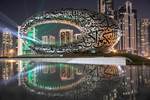Sicomin supports large-scale interior project for Museum of the Future
Sicomin aided Dubai-based Advanced Fiberglass Industries with its bio-based gelcoats and resins to meet challenging structural and fire safety specifications defined for more than 200 double-curved entrance lobby panels.

Museum of the Future interior. Photo Credit, all images: Sicomin
Sicomin (Châteauneuf les Martigues, France) is proud to have supported the build of Dubai’s Museum of the Future. Sicomin supplied its bio-based intumescent gelcoat and fire-retardant laminating resins for the production of more than 200 double-curved panels making up the interior of the Museum’s entrance lobby.
The Museum of the Future, a new addition to Dubai’s skyline by architects Killa Design, engineers Buro Happold and contractor BAM International (The Hague, Netherlands), opened on Feb. 22, 2022, and features a large percentage of composite materials within its interior construction.
For example, Advanced Fiberglass Industries (AFI, Dubai, United Arab Emirates) manufactured 230 double-curved interior panels, a unique double-helix DNA structure staircase that scales the full seven levels of the museum and 228 glass fiber-reinforced polymer (GFRP) oval-shaped light structures for the museum’s car parking area.

Lightweight, quick-to-install, durable and highly formable fire-retardant composites provided the optimum material solution for the torus-shaped Museum’s double-curved interior panels, Sicomin says, that were decorated with a raised calligraphy design featuring quotes from His Highness Sheikh Mohammed bin Rashid Al Maktoum, vice president and prime minister of the UAE and ruler of Dubai.
In what is said to be a first of its kind for a large-scale composites project, adaptable mold technology from Danish company Adapa (Aalborg, Denmark), was introduced by AFI to ensure that the interior panels could be delivered in line with the project schedule. As well as enabling the rapid configuration of each panel without the machining of traditional molds, the adaptive mold technology significantly reduced waste generated in the molding process, contributing to the building’s low-carbon LEED platinum credentials.
With a challenging structural and fire safety specification defined, Sicomin’s bio-based SGi128 intumescent gelcoat and SR1122 fire-retardant laminating epoxy were chosen for the panels. In addition to high fire properties, SGi 128 is also formulated with more than 30% carbon from renewable sources, reducing the final carbon footprint significantly.
Sicomin worked alongside the panel manufacturer, providing technical support for the fire test panels and the initial Adapa molding trials. As a result, the high-performance, fire-retardant material solution was approved by Dubai Civil Defence, as well as achieving Class A (ASTM E84) and B-s1,d0 (EN13510-1) classifications in the testing carried out by Thomas Bell-Wright.
“Sicomin’s FR epoxy solutions gave us just the right balance of structural performance, processability and fire performance that we needed for the Museum’s interior panels,” says Majid Akram Chaudhry, general manager, AFI. “We were able to quickly dial in the new techniques required to use the materials on the Adapa molds and the industrial scale-up we needed to deliver the project on time was no problem for Sicomin to manage. As a result, we were able to increase the scope significantly, as well as for the staircase and car park light fittings, too.”
Related Content
-
Materials & Processes: Fibers for composites
The structural properties of composite materials are derived primarily from the fiber reinforcement. Fiber types, their manufacture, their uses and the end-market applications in which they find most use are described.
-
JEC World 2022, Part 3: Emphasizing emerging markets, thermoplastics and carbon fiber
CW editor-in-chief Jeff Sloan identifies companies exhibiting at JEC World 2022 that are advancing both materials and technologies for the growing AAM, hydrogen, automotive and sustainability markets.
-
JEC World 2022, Part 1: Highlights in sustainable, digital, industrialized composites
JEC World 2022 offered numerous new developments in composites materials, processes and applications, according to CW senior editor, Ginger Gardiner, most targeting improved sustainability for wider applications.










.jpg;maxWidth=300;quality=90)





